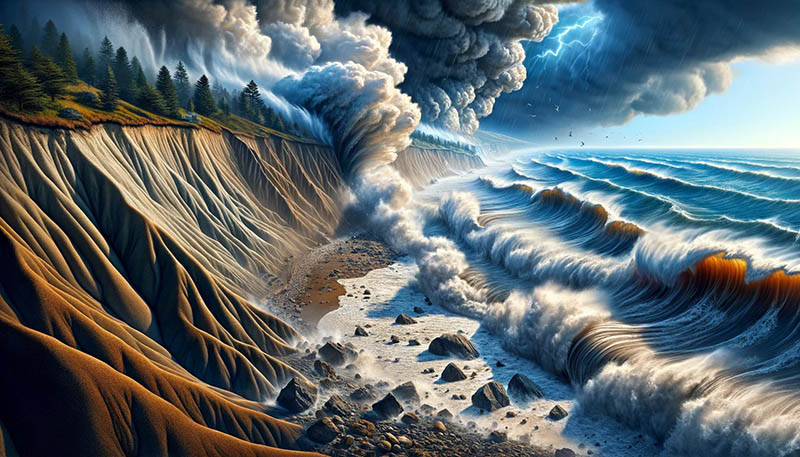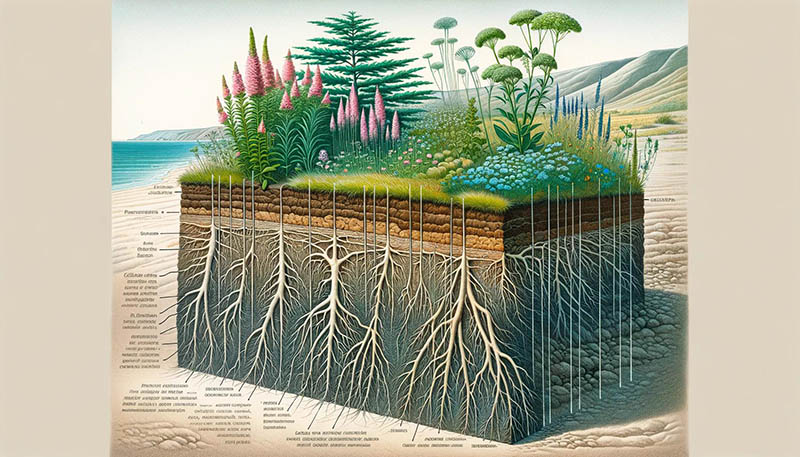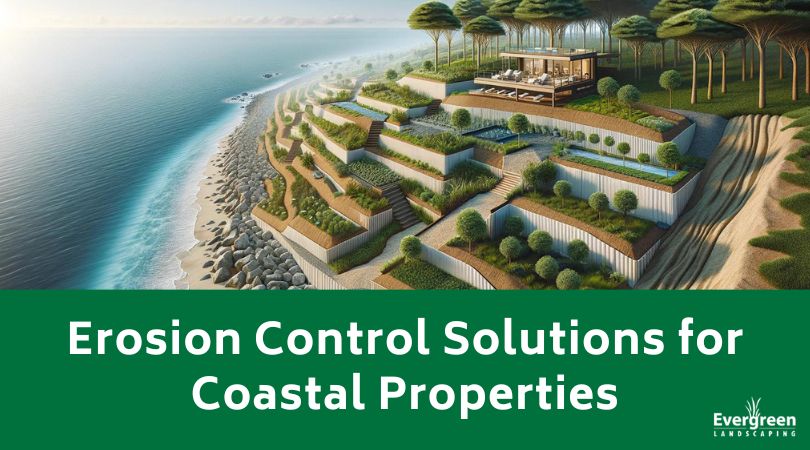Introduction
Coastal properties in central California are renowned for their breathtaking views and unique landscapes, offering residents a serene connection to nature’s beauty. However, this idyllic setting comes with its own set of challenges, notably the persistent issue of erosion. Erosion, the gradual wearing away of land by water, wind, and other natural forces, poses a significant threat to these properties. It can lead to the loss of valuable land, compromise the structural integrity of buildings, and diminish the natural beauty of the landscape. The forces of nature, combined with human activities, have accelerated erosion rates, making it a pressing concern for homeowners and environmentalists alike.
The Importance of Addressing Erosion
Addressing erosion is not just about protecting individual properties; it’s a matter of preserving the coastal ecosystem and ensuring the safety of the communities that call this region home. Effective erosion control measures are essential to maintain the stability of the land, safeguard property values, and protect the diverse flora and fauna that enrich this coastal environment. Moreover, as erosion can lead to increased sedimentation in waterways, affecting water quality and marine habitats, its management is also crucial for environmental protection. By exploring and implementing strategic erosion control solutions, property owners in central California can contribute to the long-term sustainability and resilience of their coastal landscapes, ensuring they remain vibrant and intact for future generations.
Understanding Coastal Erosion
Understanding the multifaceted causes of coastal erosion is crucial for developing effective strategies to combat it. In central California, as in many coastal regions, erosion is driven by a combination of natural and human-induced factors, each playing a significant role in shaping the landscape.

Natural Factors:
- Waves: The constant battering of waves against the shoreline is one of the primary natural forces causing erosion. During storms, the energy and frequency of these waves intensify, leading to more significant erosion.
- Wind: Wind contributes to coastal erosion by removing surface soil and sand, gradually wearing away unprotected land. In areas with less vegetation, wind erosion can be particularly destructive.
- Rain: Heavy rainfall can lead to erosion by washing away soil. In coastal areas, the runoff from rain can exacerbate soil loss, especially on slopes or areas where the ground is already destabilized.
Human-Induced Factors:
- Construction: Development along coastlines, including the building of homes, roads, and other structures, often disturbs the natural landscape, making areas more susceptible to erosion.
- Deforestation: Removing vegetation for construction or other purposes reduces the soil’s ability to hold together, increasing vulnerability to erosion.
- Seawalls and Coastal Defenses: While intended to protect properties from waves, these structures can sometimes exacerbate erosion by redirecting wave energy to other parts of the shoreline.
Impacts of Erosion on Coastal Properties:
The consequences of erosion for coastal properties in central California can be severe and multifaceted:
- Land Loss: One of the most immediate effects of erosion is the loss of land. As the shoreline recedes, property boundaries can literally shrink, leading to a reduction in property size and value.
- Weakened Structures: Erosion can undermine the foundations of buildings and other structures, leading to instability and, in extreme cases, collapse. This not only poses a risk to property but also to human safety.
- Reduced Aesthetic Value: The visual appeal of coastal properties is one of their most valued attributes. Erosion can mar this beauty, affecting not just individual properties but the overall character of the coastline.
Understanding these causes and impacts is the first step in addressing coastal erosion. By acknowledging the role of both natural processes and human activities, property owners and policymakers can work together to implement measures that mitigate erosion’s effects, preserving the integrity and beauty of coastal communities for generations to come.
Erosion Control Strategies
Erosion control is vital for preserving coastal properties in central California. Here are four effective strategies:
- Vegetation: Plants play a crucial role in stabilizing soil and absorbing excess water. For coastal areas, ground cover plants like Sea Thrift (Armeria maritima) and deep-rooted shrubs such as California Sagebrush (Artemisia californica) are excellent for preventing soil erosion. Their roots help bind the soil, reducing runoff and soil loss.

- Retaining Walls and Terracing: These structures can effectively prevent soil from moving downhill. In coastal environments, materials resistant to corrosion, such as treated wood, stone, or concrete, are preferred. Terracing, which involves creating stepped levels on a slope, can also help reduce runoff and soil erosion by breaking the slope into smaller, more manageable sections.
- Riprap (Rock Armor): Riprap consists of large stones placed along shorelines or slopes to absorb wave energy and prevent soil erosion. For coastal properties, choosing rocks like granite or limestone, which can withstand saltwater exposure, is crucial. Proper placement in areas most susceptible to wave impact can significantly reduce erosion.
- Geotextiles: These synthetic fabrics are used to stabilize soil. Suitable for coastal properties, geotextiles can be woven or non-woven, depending on the application. They’re laid under the soil to reinforce the area and prevent erosion by water or wind. Geotextiles are particularly useful in areas where vegetation alone might not be sufficient to prevent erosion.

Implementing these strategies can significantly mitigate the effects of erosion on coastal properties, preserving the land and its natural beauty.
Maintenance and Monitoring
For erosion control measures to remain effective over time, regular maintenance and vigilant monitoring are essential. These practices ensure that the implemented strategies continue to protect coastal properties from the adverse effects of erosion.
Importance of Regular Maintenance and Monitoring
- Erosion control structures and vegetation can degrade or become less effective due to natural wear, extreme weather events, or unforeseen environmental changes. Regular checks help identify issues early, preventing minor problems from escalating into significant threats to your property.
Tips for Inspecting and Maintaining Erosion Control Structures
- Routine Inspections: Schedule bi-annual or annual inspections of all erosion control structures, including retaining walls, terraces, riprap, and geotextiles. After extreme weather events, additional inspections are advisable to assess any immediate damage or necessary repairs.
- Vegetation Management: Regularly check the health and coverage of plants used for erosion control. Replace any dead or dying plants to ensure continuous soil stabilization. Pruning and managing the growth of these plants can also enhance their effectiveness in preventing erosion.
- Retaining Walls and Terraces: Look for signs of wear, such as cracks, leaning, or erosion at the base. Early detection and repair of these issues can prevent costly reconstruction. Ensure drainage systems within these structures are clear and functioning to prevent water buildup and increased pressure on walls.
- Riprap Maintenance: Inspect riprap areas for displacement or settling of rocks. After heavy storms, reposition any moved stones to maintain the integrity of the protective barrier.
- Geotextile Integrity: Check for signs of tearing, clogging, or degradation in geotextile fabrics. Replace sections that can no longer effectively stabilize the soil or facilitate proper drainage.
Maintaining and monitoring erosion control measures is a critical component of coastal property management. By taking proactive steps to inspect and maintain these structures, property owners can ensure the longevity and effectiveness of their erosion control efforts, safeguarding their land and investments against the forces of nature.
However, understanding the unique challenges of each property’s location, soil type, and exposure to natural elements is crucial for selecting the most effective erosion control measures. Therefore, we strongly encourage property owners to consult with landscaping professionals who specialize in coastal environments. These experts can provide tailored advice, design customized solutions that fit the specific needs of your property and help navigate any regulatory requirements related to coastal land management.
Taking proactive steps towards erosion control is not just an investment in your property; it’s a commitment to preserving the natural beauty and ecological balance of California’s coastal regions for future generations.
For help keeping your property in the best shape, contact Evergreen Landscaping today.

